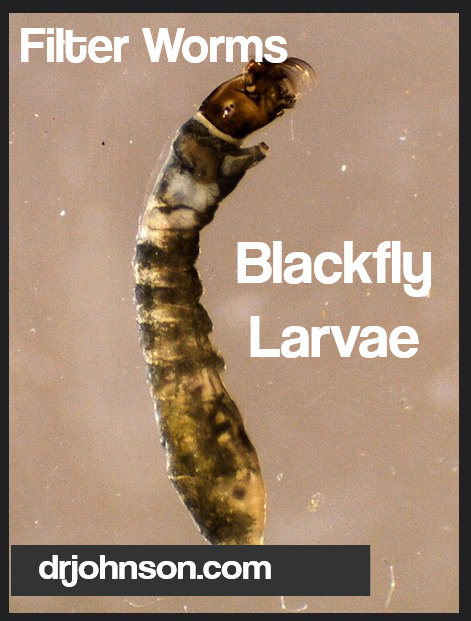Black Flies
EXCERPTED FROM: https://extension.entm.purdue.edu/publichealth/insects/blackfly.html
Black flies are true flies (Order Diptera) in the family Simuliidae, which includes more than 1,700 species worldwide. In North America, 255 species in 11 genera have been identified, but additional species remain to be discovered and named. Very little is known about black flies in Indiana, and there are no estimates of the number of species in the state. For perspective, 12 species have been documented in Illinois, while over 30 species have been documented in both Minnesota and Wisconsin, where black fly habitats are more abundant.

How Can I Recognize an Adult Black Fly?
Black flies range in size from 5 to 15 mm, and they are relatively robust, with an arched thoracic region (Figure 1). They have large compound eyes, short antennae, and a pair of large, fan-shaped wings. Most species have a black body, but yellow and even orange species exist.
What Is the Life Cycle of Black Flies?
Black flies undergo a type of development known as “complete metamorphosis” (Figure 2). This means the last larval stage molts into a non-feeding pupal stage that eventually transforms into a winged adult. After taking a blood meal, females develop a single batch of 200-500 eggs. Most species lay their eggs in or on flowing water, but some attach them to wet surfaces such as blades of aquatic grasses.
 The length of time it takes an egg to hatch varies greatly from species to species. Eggs of most species hatch in 4-30 days, but those of certain species may not hatch for a period of several months or longer. The number of larval stages ranges from 4-9, with 7 being the usual number. The duration of larval development ranges from 1-6 months, depending in part on water temperature and food supply. The life cycle stage that passes though winter is the last stage larva attached underwater to rocks, driftwood, and concrete surfaces such as dams and sides of man-made channels.
The length of time it takes an egg to hatch varies greatly from species to species. Eggs of most species hatch in 4-30 days, but those of certain species may not hatch for a period of several months or longer. The number of larval stages ranges from 4-9, with 7 being the usual number. The duration of larval development ranges from 1-6 months, depending in part on water temperature and food supply. The life cycle stage that passes though winter is the last stage larva attached underwater to rocks, driftwood, and concrete surfaces such as dams and sides of man-made channels.
Lifecycle of Black Fly Figure 2. Black fly life cycle. (Illustration by: Scott Charlesworth, Purdue University,
based in in part on Peterson, B.V., IN: IN: Manual of Nearctic Diptera, Volume 1)
The pupal stage is formed the following spring or summer, typically in the same site as the last stage larva, but may occur downstream following larval “drift” with the current. Adults emerge from the pupal stage in 4-7 days and can live for a few weeks. Adults of most species are active from mid-May to July. The number of generations completed in one year varies among species, with some having only one generation, but most species that are major pests complete several generations per year.
Black fly larvae and pupae develop in flowing water, typically non-polluted water with a high level of dissolved oxygen. Suitable aquatic habitats for black fly larval development vary greatly and include large rivers, icy mountain streams, trickling creeks, and waterfalls. Larvae of most species typically are found in only one of these habitats.
Larvae remain attached to stationary objects in flowing water, held on by silken threads extruded from glands located at the end of the bulbous abdomen. Depending on species, mature larvae range from 5-15 mm in length and may be brown, green, gray, or nearly black in color. They possess a large head that bears two prominent structures known as “labral fans” that project forward (see Figure 2). Labral fans are the primary feeding structures, filtering organic matter or small invertebrates out of the water current.
Pupae remain attached to stationary objects in flowing water as well. They typically are orange and appear mummy-like because the developing wings and legs are tightly attached to the body. Pupae of many species produce a delicate, silken “cocoon” of varying density, weave, and size that partially or nearly entirely encloses them; other species produce hardly any cocoon at all.






